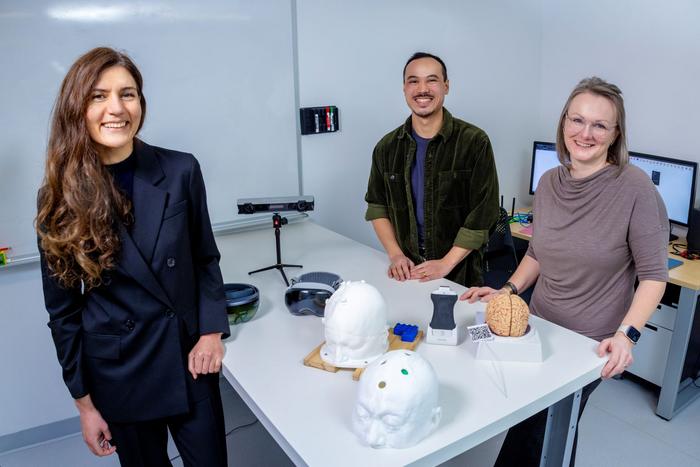
image:
Zahra Asadi, Joshua Pardillo Castillo and Marta Kersten-Oertel
view more
Access to potentially life-saving neurosurgical care remains very uneven worldwide, with potentially life-threatening consequences. This is especially true for a process called ventriculostomy, the most common neurosurgical procedure. Ventriculostomy involves the insertion of a catheter into the brain cavities called ventricles to drain cerebrospinal fluid and relieve intracranial pressure.
It’s a delicate, difficult process that requires extreme precision: misplacing the catheter, which happens in up to 30 per cent of freehand procedures, can result in hemorrhage, infection, prolonged hospital stays, morbidity and even death.
That’s why a group of Gina Cody School of Engineering and Computer Science researchers sought to improve access to low-cost technologies that can aid in improving ventriculostomy accuracy. Marta Kersten-Oertel, an associate professor in the Department of Computer Science and Software Engineering, and her team have developed an augmented-reality (AR)-based platform. They say it may make the procedure far safer and more accurate, especially in low- and middle-income countries and resource-limited settings.
The iSurgARy system uses LIDAR, a light detection and ranging technology, to help surgeons identify specific landmarks on the skull and accurately map them to the patient’s preoperative images (CT/MRI). Augmented reality is then used to project the ventricles onto the patient. The creators describe the technology in the Healthcare Technology Letters journal.
“The technology offers better spatial awareness of patient anatomy, which provides surgeons better aim at their target points,” says co-author Joshua Pardillo Castillo, MSc 24. “The augmented reality overlays the patient’s medical images to better see how they can best position the catheter.”
Precision brain mapping
LIDAR, available on Apple’s iOS devices, helps determine distances from the sensor to seven anatomical landmarks on the patient’s head: the tragus (the pointed eminence jutting out from the scalp at the front of the ear) on both sides of the head, the outer eyes, the inner eyes and the bridge of the nose. These landmarks are used to align the virtual models of the patient’s anatomy to the actual patient, providing the medical personnel with an augmented reality view that shows them where the ventricles are.
This visualization guides the clinician to the optimal location for catheter placement, while the catheter’s tracking tool can provide spatial understanding of the distance between the tip of the catheter and the ventricles.
“The AR view shows where the ventricles are so clinicians can decide on the best approach,” Kersten-Oertel explains. “The freehand technique relies on bony landmarks of the skull, and clinicians make their decision based on them. But if there is a brain tumour that is causing pressure or a traumatic brain injury, the brain may have shifted so the ventricles are not where they are expected to be. This system allows users to see the ventricles projected on the patient and accurately target them.”
The researchers point out that the platform emerged out of a practical need identified by an experienced clinician — David Sinclair, a clinical professor in cerebrovascular and skull base neurosurgery in the Division of Neurosurgery of McGill University’s Department of Neurology and Neurosurgery and a co-author on the paper. Sinclair asked Kersten-Oertel if it was possible to develop a tool that improves visualization to target ventricles in emergent scenarios where time, cost and accuracy are of utmost importance.
“This kind of collaboration with a neurosurgeon in the design and discovery phase makes this whole project unique,” says Zahra Asadi, a PhD student and co-first author on the paper.
“Working with him and getting to know the needs of the people who will be using this application is critical.”
Read the cited paper: “iSurgARy: A mobile augmented reality solution for ventriculostomy in resource-limited settings.”
Journal
Healthcare Technology Letters
DOI
10.1049/htl2.12118
Method of Research
Imaging analysis
Subject of Research
People
Article Title
iSurgARy: A mobile augmented reality solution for ventriculostomy in resource-limited settings
Article Publication Date
15-Jan-2025
COI Statement
The authors declare no conflicts of interest.
Media Contact
Patrick Lejtenyi
Concordia University
Office: 514-848-2424 x5068
Journal
Healthcare Technology Letters
DOI
10.1049/htl2.12118
Journal
Healthcare Technology Letters
DOI
10.1049/htl2.12118
Method of Research
Imaging analysis
Subject of Research
People
Article Title
iSurgARy: A mobile augmented reality solution for ventriculostomy in resource-limited settings
Article Publication Date
15-Jan-2025
COI Statement
The authors declare no conflicts of interest.
Keywords
/Health and medicine/Medical specialties/Surgery/Neurosurgery
/Life sciences/Organismal biology/Anatomy/Musculoskeletal system/Skeleton/Bones/Skull
/Health and medicine/Medical specialties/Surgery/Surgical procedures
/Life sciences/Organismal biology/Anatomy/Nervous system/Central nervous system/Human brain
/Health and medicine/Biomedical engineering/Medical technology
/Scientific community/Research programs/Clinical research
/Applied sciences and engineering/Applied physics/Applied optics/Lidar
/Life sciences/Organismal biology/Anatomy/Body fluids/Cerebrospinal fluid
/Health and medicine/Diseases and disorders/Symptomatology/Bleeding
bu içeriği en az 2000 kelime olacak şekilde ve alt başlıklar ve madde içermiyecek şekilde ünlü bir science magazine için İngilizce olarak yeniden yaz. Teknik açıklamalar içersin ve viral olacak şekilde İngilizce yaz. Haber dışında başka bir şey içermesin. Haber içerisinde en az 12 paragraf ve her bir paragrafta da en az 50 kelime olsun. Cevapta sadece haber olsun. Ayrıca haberi yazdıktan sonra içerikten yararlanarak aşağıdaki başlıkların bilgisi var ise haberin altında doldur. Eğer yoksa bilgisi ilgili kısmı yazma.:
Subject of Research:
Article Title:
News Publication Date:
Web References:
References:
Image Credits:
Keywords
Tags: advancements in neurosurgical practicescatheter placement accuracycerebrospinal fluid drainageglobal health disparities in neurosurgeryinnovative medical technologyintracranial pressure managementneurosurgical care accesspatient safety in surgeryRevolutionary Concordia Apprisks of ventriculostomy surgerysurgical precision enhancementventriculostomy procedure improvements





